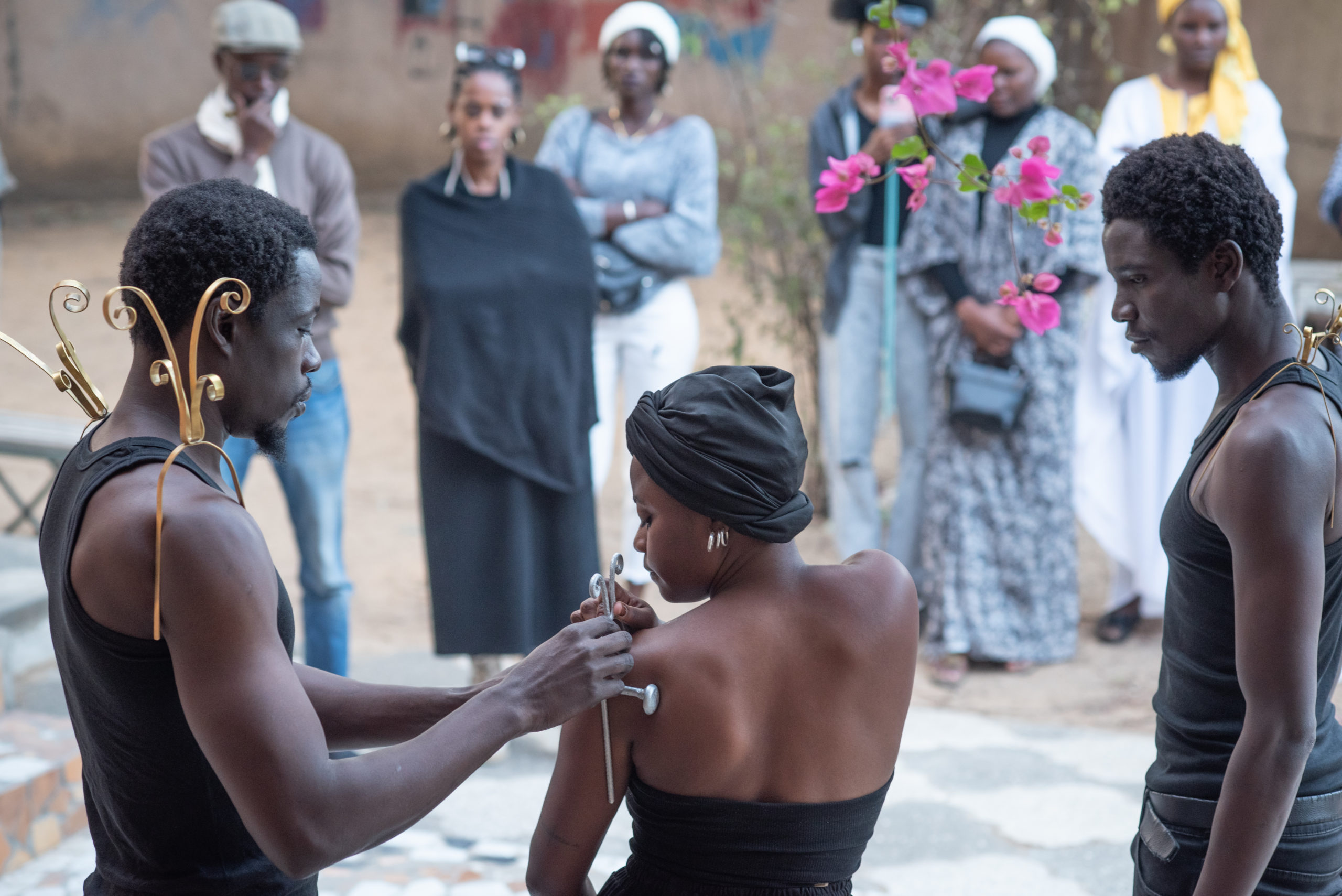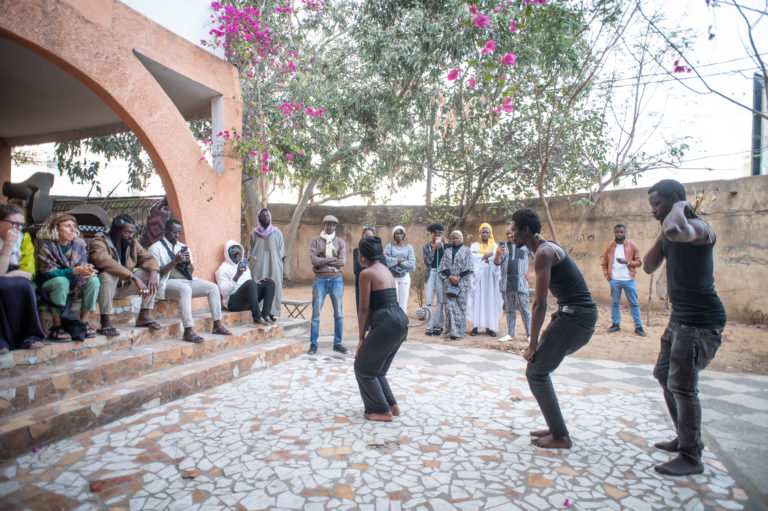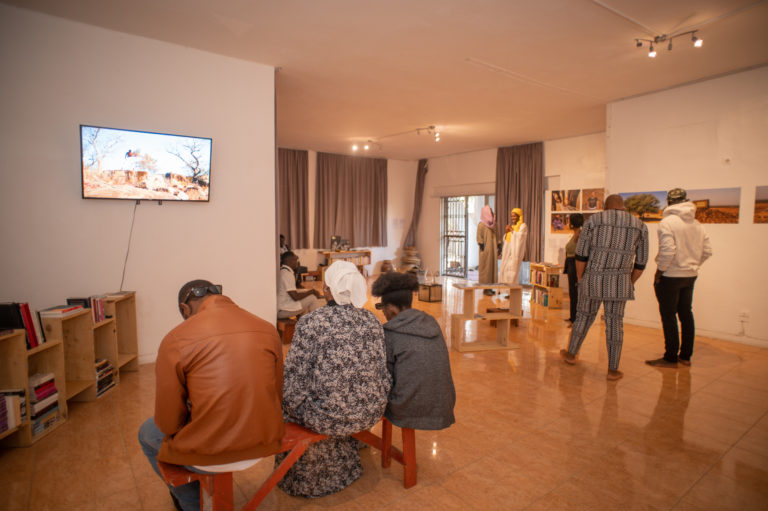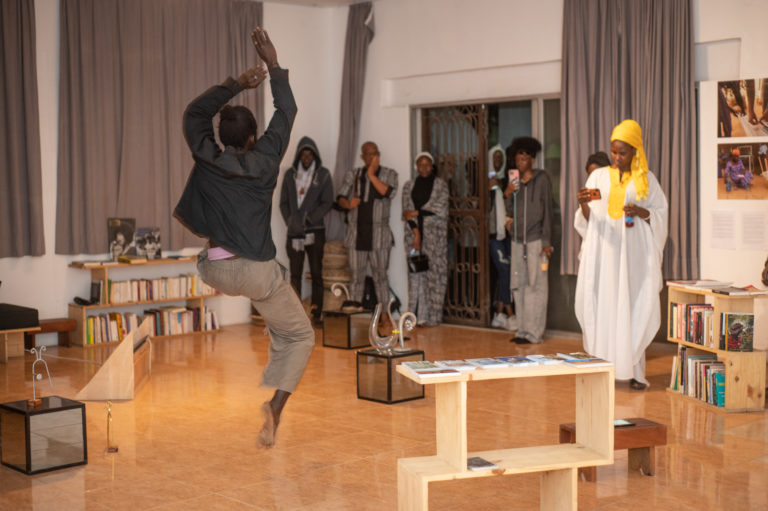The Opera Village goes Dakar!

In March, the second part of our residency program took place in Dakar, Senegal. Together with our local project partner RadioAWU, we organized an exhibition that provided insights into the artistic research and results of this year’s resident artists. The presentation opened a diverse program that spanned audiovisual works, tactile objects, and discursive approaches. All the artistic positions gathered in the exhibition engage in different ways with issues of memory, identity, body politics, and postcolonial power dynamics.
Godelive Kasangati Kabena from the Democratic Republic of Congo presented her work “Speculative Bodies: The Tail and the Scent,” in which she explored the Basenji dog as an archival and speculative object. Starting with the shape of the dog’s characteristic curled tail and the symbolism of its pheromones, she developed wearable objects and sculptural works. In collaboration with local aluminum foundries and jewelry artisans, she created pieces that addressed questions of corporeality, reproduction, and the fluidity of image and identity. For us, this opened an exciting dialogue about the archival image as a constantly reshaping, speculative structure.
 Christopher Nelson Obuh from Nigeria focused on the history and present of the Franc CFA with his project “The Renegotiation” — the currency of many West African countries that still remains under French influence. Through the artistic reconstruction of banknotes and their layering with everyday, political, and historical fragments, he engaged with economic dependencies and the complex forms of colonial continuities. This work provided us with important insights into the exploration of economic self-determination in postcolonial contexts.
Christopher Nelson Obuh from Nigeria focused on the history and present of the Franc CFA with his project “The Renegotiation” — the currency of many West African countries that still remains under French influence. Through the artistic reconstruction of banknotes and their layering with everyday, political, and historical fragments, he engaged with economic dependencies and the complex forms of colonial continuities. This work provided us with important insights into the exploration of economic self-determination in postcolonial contexts.
 Leila Bencharnia from Morocco presented “The Politics of Softness,” a poetic exploration of cotton as a material, a carrier of memory, and a symbol of feminized knowledge practices. Her works combined textile elements, matriarchal narratives, and Pan-African thought to offer a quiet yet resolute critique of imperial time and power structures. For us, this position was a striking example of how artistic practice can create spaces for alternative forms of resistance and collective knowledge.
Leila Bencharnia from Morocco presented “The Politics of Softness,” a poetic exploration of cotton as a material, a carrier of memory, and a symbol of feminized knowledge practices. Her works combined textile elements, matriarchal narratives, and Pan-African thought to offer a quiet yet resolute critique of imperial time and power structures. For us, this position was a striking example of how artistic practice can create spaces for alternative forms of resistance and collective knowledge.
 The exhibition created a space that allowed visitors to engage with the individual artistic positions as well as the activities of our project. It was important for us to provide a framework for intercultural exchange and networking. The artists addressed themes such as memory, identity, body politics, and colonial power structures – topics that are also central to the work of the Opera Village. The collaboration with Radio AWU and the interactions with the local audience demonstrated the potential of such collaborative formats: they open spaces for societal discussions and create intercultural connections that extend beyond the Opera Village. The project powerfully showcased the potential of The Opera Village as a platform for intercultural dialogue and as a place where art serves as a tool for societal transformation. Beyond the individual artworks, the exhibition was a great example of how art can bridge different cultures and realities.
The exhibition created a space that allowed visitors to engage with the individual artistic positions as well as the activities of our project. It was important for us to provide a framework for intercultural exchange and networking. The artists addressed themes such as memory, identity, body politics, and colonial power structures – topics that are also central to the work of the Opera Village. The collaboration with Radio AWU and the interactions with the local audience demonstrated the potential of such collaborative formats: they open spaces for societal discussions and create intercultural connections that extend beyond the Opera Village. The project powerfully showcased the potential of The Opera Village as a platform for intercultural dialogue and as a place where art serves as a tool for societal transformation. Beyond the individual artworks, the exhibition was a great example of how art can bridge different cultures and realities.
This year’s Artist-in-Residence program is supported by



